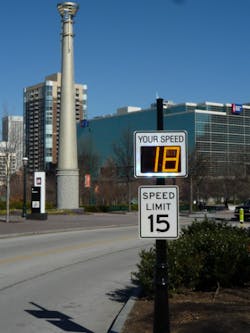Top 5 Unexpected Benefits of Radar Speed Signs
In the 15 years since radar speed sign technology first burst onto the scene, law enforcement departments have been eager to make them part of their traffic calming efforts. This is because the signs are scientifically proven to help reduce drivers’ speeds in both the short and long term. Also known as driver feedback signs, they are budget friendly with low start-up costs and no scheduled maintenance costs.
However, you may be surprised to learn that “effective and affordable” aren’t the only benefits offered by this popular traffic calming solution. According to Charlie Robeson, cofounder and managing partner at Radarsign, there are a number of lesser-known pluses that make them even more attractive. And he’s got data to prove it.
In many cases, the installation of a new sign delivered unexpected wins and some unknown benefits.
- Answer a burning, community-wide question: Is speeding actually a problem? Complaints about speeding drivers in residential areas are one of the most common citizen complaints faced by local police departments. Taxpayers want—and deserve—to have their concerns addressed with appropriate care and consideration. Those complaints, which are not limited to any specific geographic area, require a portable way to document driver behaviors (portability should be a key consideration when evaluating driver feedback signs). Some manufacturers offer signs small enough to fit in the trunk of a car, lightweight enough to be installed in minutes by only one officer. Pair this up with software that captures data on driver behaviors and any police department can prove or disprove whether speeding is actually a problem. It’s an efficient and compassionate option.
- Educate the public and make better, happier citizens. Impossible you say? Nope, it’s true. There is some really interesting science about how the brain responds to driver speed signs (called feedback loops) that essentially says, Let people know when they are speeding, give them an opportunity to correct their behavior and they will. That’s educating drivers and helping them to be good citizens. The public appreciates a gentle reminder far more than flashing blue lights in the rearview mirror. And an absence of speeding tickets makes for happier citizens.
- Driver feedback signs can solve budget and manpower issues - Without robotic stand-ins for police officers, we have to be content with automated features that make very tangible improvements. Radar driver speed signs do accomplish this by automatically reminding drivers to slow down, freeing officers to focus on urgent situations. This, combined with the affordability option, means that most law enforcement departments should see a return on their investment in less than 12 months.
- Support faster response times of first responders - We have long known that vertical alterations for traffic calming, like speed bumps and humps, can have a big impact on the work of our fellow first responders. Each hump, bump and even chicane can slow an ambulance or fire truck by 10 seconds. And when lives are on the line, seconds matter.
- Adoration and beautification - Let’s be honest, drivers don’t love most traffic calming initiatives. But in a world where they despise speed humps and bumps, driver feedback signs have found legions of fans. In fact, the huge majority of citizens respond positively. These signs look good and can be ordered with custom poles in aluminum or black, enhancing the communities they serve. Even the most persnickety critics can get behind this.
Traffic calming may not be every officer’s favorite daily task, but it’s an important one. Be safe out there.
About the Author
Lt. Scott Clayton
Lt.
Lt. Scott Clayton started his career in Georgia with the Marietta Police Department in 1984 after serving four years as a member of the 82nd Airborne Division. During his time as an officer he was assigned to uniform patrol, DUI Task Force and the Marietta/Cobb/Smyrna (MCS)Drug Task Force. After promotion to Sergeant, Clayton became supervisor of the Selective Traffic Enforcement Program (STEP) and supervised the investigation of serious/fatality vehicle crashes and conducted city-wide traffic enforcement. In 1999 Clayton was selected as supervisor of the Crime Interdiction Unit (CIU) and carried out tactical street level crime/drug enforcement. He was later assigned to the Community Response Unit and coordinated crime prevention and education. After promotion to Lieutenant he worked as commander over STEP and CIU. During his 29 year career he spent 24 as a member of the Marietta SWAT team and was commander of the unit at the time of his retirement in 2013.
